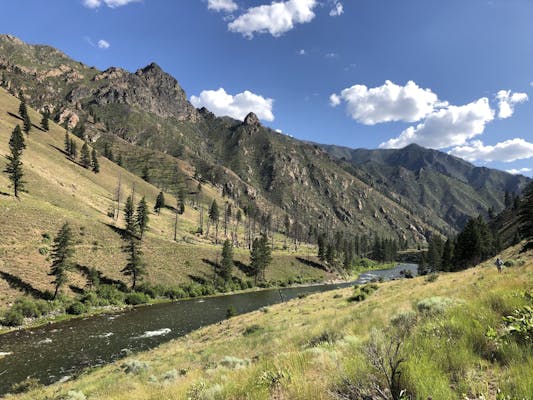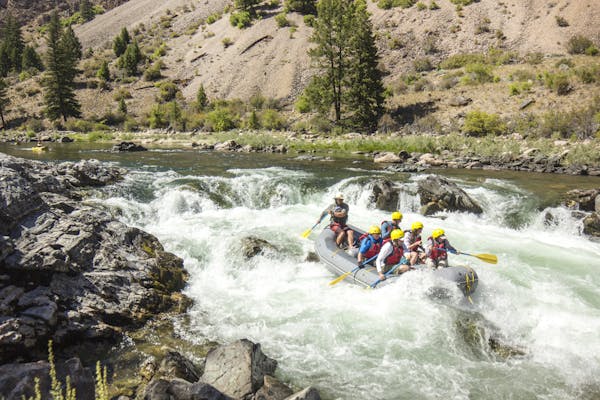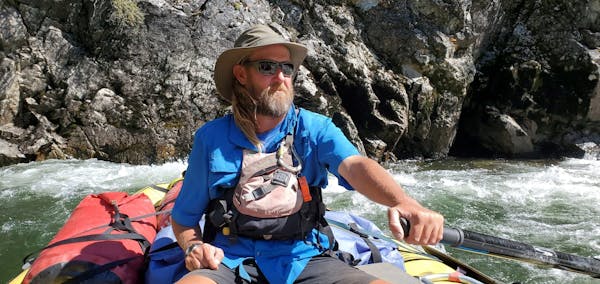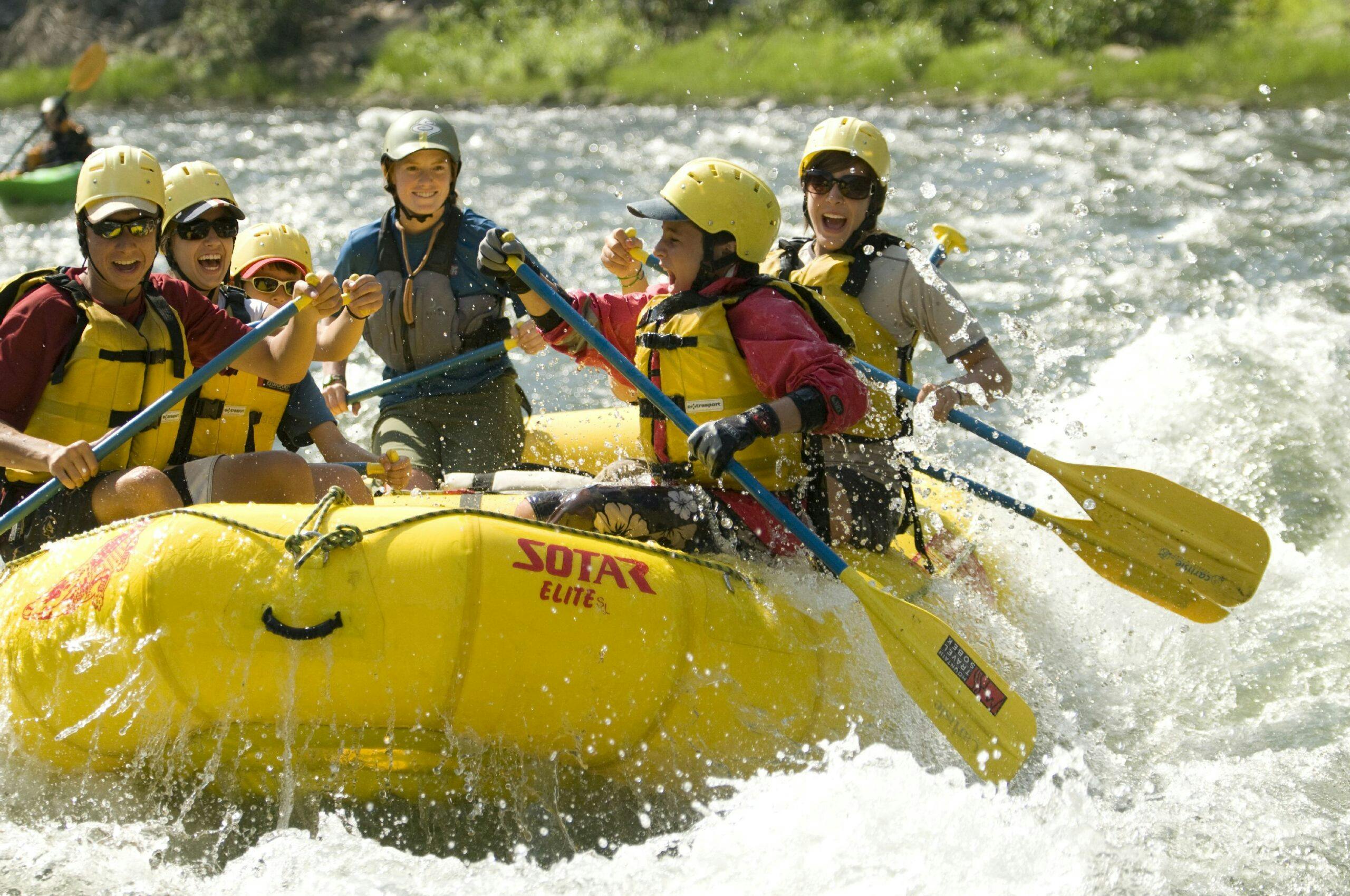
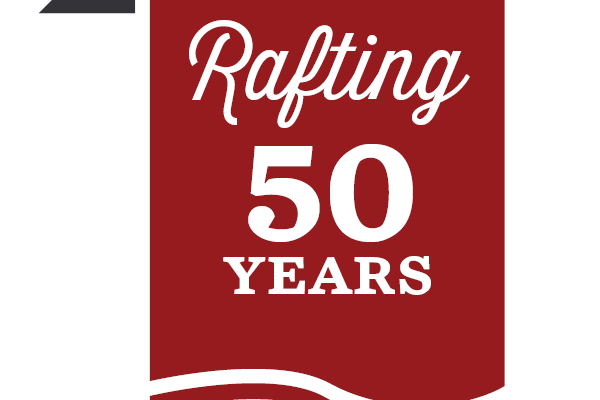
Rafting the Middle Fork of the Salmon River in Idaho
One of the world’s greatest whitewater rafting experiences, the Middle Fork of the Salmon River provides a true adventure trip of a lifetime. It carves a northeasterly route through the central Idaho backcountry, with hundreds of thrilling rapids along its 3,000 foot vertical drop. Dotted with hot springs, beaches, and waterfalls, the Middle Fork passes through soaring canyons and thick spruce forests, offering a memorable adventure for beginner and expert rafters alike.
Our Middle Fork of the Salmon River Rafting Trips
- June and July dates, typically higher water levels (especially in June with snow melt)
- Put it at Boundary Creek and power through upriver rapids like Sulphur Slide, the Chutes, and Pistol Creek
- Float through gentle river stretches, hopping out to swim
- Hike the shoreline, fish for trout, spot wildlife from eagles to elk and more
- Stop for dips in hot springs, cool off under waterfalls
- Relax on sandy river beaches, taking it all in
- Feast on gourmet campfire cuisine
- Camp along the riverbank beneath a canopy of stars
- Traverse the incredible Impassable Canyon, a reddish cliff wonder
- August dates, typically lower water level but same epic experience
- Fly into the Frank Church Wilderness to put in at Indian Creek
- Raft Class II-IV rapids with experienced guides at the helm
- Ride inflatable “ducky” kayaks or swim gentle stretches of crystal-clear waters
- Relax on sandy river beaches, taking it all in
- Enjoy fly fishing, wildlife watching, hiking, stargazing and more
- Traverse the incredible Impassable Canyon, a reddish cliff wonder
- Camp along the riverbanks and
- Feast on gourmet meals created by the campfire
- Great dates for families!
FAQs About Our Salmon River Trips
What is the difference between the 100-mile trip and the 75-mile rafting trip?
The 100-mile trip in June and July starts at Mile 1 at Boundary Creek and runs to the takeout at Cache Creek, just after the Middle Fork of the Salmon and main Salmon merge. When the water levels go down in August it is more challenging to run the upper section of the Middle Fork, so we fly into Indian Creek at mile 25. The rest of the trip is exactly the same as the 100-mile version. Both MT Sobek Middle Fork options have been created for a stress-free experience, including both pre-and-post hotels and flights.
Are meals and camping included on the Middle Fork of the Salmon River?
Yes! Your Middle Fork of the Salmon River rafting experience includes all meals and snacks. Wine and beer is not included but can be brought on the trip for personal consumption. We also provide all the camping gear including roomy dome tents, camping pads, and freshly laundered sleeping bags. Each day, our set-up team will raft ahead to ensure that everything is ready for you when you arrive at camp.
Do I need to have prior rafting experience to raft the Middle Fork of the Salmon River?
This trip is rated activity Level 2. Previous rafting experience is not necessary, but you need to be in good physical condition. This trip occurs in a remote wilderness location, where each day loading and unloading into the raft can be on sandy beaches or uneven rocky shores. It is a necessity that all travelers are stable and sturdy on their feet in uneven terrain.
What is the maximum group size?
For scheduled departures, the maximum number of guests that we can take is 20 and the minimum is 7. You can sign up as a solo, as a couple, or as a small or large group until we max out our space. Looking to take over an entire date for your own private group? Call us on 800-974-0300 for more details.
Is this trip good for families? Is there a minimum age?
Yes, the Middle Fork of the Salmon River is an excellent trip for small and large families and no prior rafting experience is required. Check out our current family savings! The minimum age on our family friendly departures is 7. For any other departure the minimum age is 18.
About the Middle Fork of the Salmon River
The Middle Fork of the Salmon River is a 104-mile-long river in Central Idaho, smack in the center of the 2.5-million-acre Frank Church – River of No Return Wilderness, the largest roadless area in the Lower 48. A tributary of the main Salmon River, the Middle Fork is a whitewater rafting paradise, with a 3,000-foot elevation drop and hundreds of rapids along the way. The nearest town to the river is Stanley, ID, population 119.
The Middle Fork stands alone as the wildest, healthiest, and most pristine river system in the continental U.S. It’s one of the world’s most crucial habitats for salmon and steelhead, and the heart and soul of the Frank Church-River of No Return Wilderness, the largest roadless wilderness in the lower 48.
Renowned for its remote beauty, the Middle Fork is widely regarded as the premier multi-day wilderness whitewater excursion in America. It’s truly the whitewater trip of a lifetime.
Rafting the Middle Fork of the Salmon River in Idaho typically ranges from 4 to 6 days, covering 75 or 100 miles of pristine wilderness. However, actual timing can be influenced by factors like water levels, group pace, and chosen itinerary. MT Sobek trips include 5 days on the river.
Water levels on the Middle Fork of the Salmon River vary based on snowmelt and seasonal precipitation. Generally, they’re highest in June from snowmelt runoff, gradually decreasing through July and August. MT Sobek runs Middle Fork trips in June, July, and August.
Each month brings its own type of experience. What’s “best” is often a matter of personal choice.
– In June, you’ll typically find lush, bright green shoreline grasses and the most exciting rapids, with high water levels creating fast travel for rafts. More daylight means more time for exploring riverside hiking trails, too. But days can be cool and rainy, and the water is pretty cold.
– The weather and water warm up in July, and the water is usually still running high enough to enable floating on the river’s upper 25-mile section. Conditions are usually ripe for more water play, including swimming, fishing and floating in inflatable kayaks.
– Many river veterans secretly love August! Though the water is running lower, more exposed rocks make the rapids more technically challenging, a thrill for skillful guides. Lower water levels also mean expanded access to sandy riverside beaches, and crystal-clear water that create even more opportunities for playing in and out of the water. August is a great time for family trips on the Middle Salmon.
Note that conditions vary each year, depending on the weather and past winter’s snowpack. MT Sobek’s expert Travel Consultants can provide water level information for your trip or you can check local river forecasts.
Rafting & Boats
What are the rapids classes on the Middle Fork of the Salmon River?
The Middle Fork Salmon River features rapids ranging from Class II to Class IV. It’s a mix of exciting yet manageable whitewater sections interspersed with calm stretches, making it suitable for beginner and experienced paddlers.
What are some famous Middle Fork Rapids?
Some of the most well-known rapids on the Middle Fork of the Salmon are:
Velvet Falls
A Class IV rapid known for its steep drop and challenging hydraulics, providing an exhilarating experience for rafters and kayakers alike.
Dagger Falls
Another Class IV rapid, characterized by its powerful hydraulics and narrow channel, offering an adrenaline-pumping ride through turbulent waters.
Powerhouse
A Class III+ rapid featuring dynamic waves and obstacles, providing an exciting challenge for intermediate paddlers and adding to the thrill of navigating the Middle Fork.
Devil’s Tooth
A Class IV rapid with technical features, including large boulders and powerful currents, demanding precise navigation and offering an unforgettable whitewater experience.
River Classifications

Class I-II Rapids
Sit back and enjoy the scenery. Experience placid river conditions with interspersed wave trains and enjoyable splashes.

Class III-IV Rapids
Things are getting exciting! Begin to see more frequent irregular waves. This level requires a good response to guide commands and efficient team paddling.

Class V Rapids
This is the highest level of rafting difficulty, likely involving long, continuous rapids. Successful navigation requires great physical fitness and precise paddling.
What type of boats will I get to use on the Middle Fork of the Salmon River?
We use a variety of boats, including oar boats, with two long oars rowed by forward-facing guides, inflatable kayaks, and paddle boats, which are powered by up to six passengers under the direction of their guide. The combination of boats will vary based on the number of people and water levels of each trip.
River Rafting Terminology

Oar Boat
Classic inflatable raft, equipped with two long oars rowed forward-facing by the guide. Accommodates gear and 2-3 passengers. Perfect for relaxing.

Paddle Boat
Up to 6 passengers sit on the perimeter of the raft with legs inside and paddle under the direction of the guide, who sits in the stern of the raft.

Gear Boat
Also called the sweep boat, the gear boat carries all the camp necessities, plus all our waste ensuring that we leave the river as pristine as we found it.

Inflatable Kayak
“Duckies” are your chance to get intimate with the river. Paddle or sit at river level with a double-bladed paddle and be in charge of your own

Stand-Up Paddleboard
Balance on these surprisingly stable craft, also known as SUP, and propel yourself downstream with a single-bladed paddle

Portage
When rivers become un-navigable, the gear has to be taken out and carried to the next navigable stretch. This is known as portage.
Where is the put in and take out for the Middle Fork of the Salmon River?
When the water level is high, typically in June and early July, the put in is at Boundary Creek. Our 100-mile trips depart from Boundary Creek.
When the river is running at a lower level, from mid-July through August, the put in point is Indian Creek (Mile 25), which has a small riverside airstrip. Our 75-mile trips start from here.
The take-out point for the Middle Fork of the Salmon River is typically at Cache Bar (Mile 97), where rafters end their journey with a celebratory hurrah before being met by shuttle services.
How hard is paddling the Middle Fork Salmon River?
The Middle Fork Salmon River is considered a moderate-to-challenging whitewater rafting experience, depending on the time of year and water level. There are 100 rapids, including Class II, III and IV rapids, making it suitable for experienced paddlers and those seeking an adventurous river trip.
MT Sobek’s expert Travel Consultants can help you select the departure that best matches your expectations and experience.
Middle Fork of the Salmon River Experiences
A typical day on the Middle Fork starts with fresh, hot coffee prepared by your river guides, who rise at the crack of dawn to start breakfast. You can savor a cup or sleep in until breakfast is called. After eating, guests gather their personal gear as guides pack up camp and load gear onto boats. The group then decides who’ll ride where in which boat, ensuring everyone has a chance to try different rafting experiences during the trip.
Depending where you camped, the river will either start with a gentle float or a quick succession of fun rapids. As the day goes on, you’ll have plenty of rest stops and time to explore historic or natural sites along the river corridor. After a hearty lunch break, it’s back in the raft for more water fun.
You’ll pull into camp mid- to late afternoon and have some snacks and drinks before tucking into a hearty meal prepared fresh by the guides. Enjoy games and camaraderie with the group in the evening and check out the incredible moonscape and canopy of stars overhead before settling into your tent for the night.
Absolutely! The Middle Fork has tons of hiking opportunities, everything from a short stroll along the riverbank to a longer hike up the canyon walls where epic viewpoints await. The Middle Fork River Trail parallels the water for 78 miles, nearly its entire length. While we generally plan on at least two guided hikes during the trip, there are plenty of opportunities to explore the area. All hikes are optional. If hiking’s not your thing, you can choose to lie on the beach and take in the rays, soak in a hot spring, or read a book instead.
Yes. The Middle Fork of the Salmon River corridor features many natural attractions along the way, from hot springs and waterfalls to epic viewpoints high above the river. There’s plenty of scenery for feasting your eyes. Rafters are often surprised by the variety of interesting sites along the way, including Shoshone pictographs, old farmsteads, and the remnants of forgotten mines. It’s pretty cool to see horses on the ranches and maybe even savor an ice cream in the wilderness.
You can. Permitted catch and release fly fishing on the Middle Fork of the Salmon River offers anglers an unparalleled experience. With its crystal-clear waters and abundant trout populations, the Middle Fork is a haven for fly fishing enthusiasts seeking solitude and pristine natural surroundings.
Fisherfolks can expect to encounter native cutthroat trout, rainbow trout, and occasionally elusive steelhead, all thriving in the river’s healthy ecosystem. As participants adhere to catch and release regulations, they contribute to the preservation of this remarkable fishery, ensuring future generations can enjoy the thrill of fly fishing in this breathtaking wilderness setting. Guides can help keen anglers obtain permits at the start of the trip.
On favorable days, anglers can hook plenty of fish, whether casting from a boat, into side creeks, or even while perched on a rock at camp. Lower flows typically occur from July to September, presenting optimal conditions for dry fly fishing. It’s crucial to check the regulations and obtain a license before embarking on your angling adventure.
While MT Sobek trips are not fishing focused, we do supply the basic gear needed to give it a try while in camp and occasionally on the boats. We welcome avid fishermen to bring their own equipment.
From alpine forests to sweeping desert canyons, the isolated expanses of the Middle Fork support an incredible array of wildlife. Large mammals such as bighorn sheep, deer, elk, moose, black bear, mountain lion, wolf, lynx, and wolverine can be encountered in these rugged landscapes. Raptors, including the golden eagle, osprey, and red-tailed hawk, gracefully soar the skies, while countless migratory birds flock to the area during spring and summer.
However, it’s important to note that wildlife sightings are not guaranteed. Despite the abundance of wildlife, their presence is subject to various factors such as season, weather, and habitat conditions.
The Impassable Canyon refers to a particularly rugged and remote section of the Middle Fork Salmon River that runs for the last 20 miles of its course. Characterized by steep, stunning cliffs and challenging terrain it is the second deepest canyon in North America and a breathtaking part of the journey, showcasing the river’s wild and untamed beauty.
Besides rafting, the Middle Fork offers plenty of other activities:
Hiking: Explore the surrounding wilderness by embarking on hikes along the riverbanks or into the nearby canyons. Numerous trails offer breathtaking views and opportunities to observe wildlife.
Fishing: The Middle Fork is famous for its fishing opportunities. Cast your line for native cutthroat and rainbow trout in the pristine river waters.
Swimming: Take a refreshing dip in the crystal-clear Middle Fork to cool off during warmer days. Many stretches of the river offer safe and inviting swimming spots.
Wildlife Viewing: Keep a lookout for the diverse wildlife that inhabits the area: deer, elk, bighorn sheep, eagles, moose, and more. Binoculars can enhance your viewing experience.
Photography: Capture stunning landscapes, rugged canyons, and vibrant flora and fauna with your camera. The Middle Fork offers countless opportunities for memorable shots.
Relaxing: Take advantage of the serene surroundings to unwind and recharge. Lounge by the riverbank, enjoy a picnic, write in your journal, or stargaze at night. You’ll have plenty of ways to relax and soak in the natural beauty of the area.
Exploring Cultural Sites: Learn about the area’s rich history by visiting historical sites, such as Native American petroglyphs, old mining sites, and remnants of homesteads along the river.
Stargazing: Far away from the city lights, the Middle Fork provides an excellent opportunity for stargazing. On clear nights, marvel at the brilliance of the night sky and constellations overhead.
Clothing & Gear
What to wear for a guided whitewater rafting trip on the Middle Fork of the Salmon River?
Prioritize comfort and safety when you choose what to wear on a Middle Fork whitewater rafting trip. We recommend opting for layers that keep you warm, dry, and protected from the sun. Wear quick-drying clothing like synthetic shirts and shorts or pants. It’s essential to have sturdy water shoes or sandals with good traction to navigate rocky riverbanks. Never choose flip-flops or other unsecured footwear. Remember to bring a wide-brimmed hat, neck covering and sunglasses for sun protection during your adventure.
Whitewater rafting clothing basics
Average water temperatures on the Middle Fork of the Salmon River run from the low 50s in June to the mid 60s in July and August. In the mornings the air will be chillier, so rafters often start the day with a layer of waterproof pants over synthetic leggings or board shorts. As the sun comes over the top of the canyon peaks, rafters start to warm up and usually shed the waterproofs by midday. A thin, synthetic long-sleeve layer underneath your personal floatation device (PFD) is a great way to ensure both warmth and sun protection. A Capilene hoodie is always a top choice of professional river guides.
Dress in synthetic layers: Opt for clothing made from quick-drying synthetic or wool fabric (not cotton). Materials like polyester, nylon or merino wool can help you maintain a comfortable core body temperature and stay warm even when you’re wet. We recommend thin top layers for under your PFD, such as a stretchy rashguard or water shirt, and an extra mid or base layer if you need to warm up. On the bottom, wear a bathing suit, board shorts or other quick-drying layer. Lightweight, quick-drying pants or synthetic leggings are good too as they’ll keep your knees from getting too much sun.
The weather can be variable on the Middle Fork of the Salmon River, with blazing sun followed by cold scattered showers. Consider these additional items to help you stay warm and dry during inclement weather:
- Paddle jacket: A paddle jacket can help keep you warm on top. A waterproof, breathable rain jacket will work, too, but paddling-specific tops have gaskets to more effectively keep water out, however they are difficult to quickly get on or off.
- Splash pants: The same is true for pants. You can wear any kind of rain pants, but splash pants made for being on the water are sealed at the ankles to help keep you dry. They’re a good choice for layering over shorts or leggings when the weather turns stormy.
Wear sun protection: Protect your skin with a sun hat, sunglasses, neck covering and sunscreen. Factor 50+ sun cream and a lip block is great – look for options containing zinc oxide. A neck buff that can be pulled over your head or a thin hoodie is a good choice to keep your ears protected.
Keep safe with a personal flotation device (PFD): You will be given a PFD to wear at all times while on the water. Guides will help you to fit it correctly and will show you how to buckle each strap. If you are in the paddle boat or an inflatable kayak, you will also be required to wear a helmet.
River footwear: The best shoes for rafting are ones that stay on your feet and can get wet. Choose water shoes, water sandals with a heel strap, or an old pair of sneakers you don’t mind getting soaked. If it’s chilly, you can wear wool or neoprene socks under your shoes or sandals. Flip-flops will NOT do the trick.
Headwear: Bring a wide-brimmed paddling hat or a baseball cap. Make sure your cap can be cinched tight to keep it from getting washed overboard if a big wave crashes over the raft. Though you may be given a helmet, a cap visor and thin hoodie offers added sun protection.
Eyewear: Polarized sunglasses are a smart pick for a long day on the water since they help reduce reflection and glare coming off the river. Don’t forget a retention strap—one that floats and secures tightly to your shades is best.
Opt for zippered pockets: Secure essential accessories like your keys, a whistle or credit card in a zippered pocket before pushing off. Trust us, it’s nearly impossible to find your stuff at the bottom of the river. Make sure you also place any important electronic items, like a phone or car fob, inside a waterproof case.
A change of clothes: You’re likely going to be soggy after you get off the river, so remember to bring a stash of dry clothes to change into. It’s fine to wear cotton once you’re warm and dry.
Paddle gloves: Paddle gloves can help keep your extremities warm in cold water and cold, rainy conditions. And they offer the added benefit of helping to prevent blisters.
Dry bags: MT Sobek will provide a small dry bag to act as your personal day bag. Make sure everything you want with you while on the water is in it each day. Your camp life and sleeping equipment bag will travel in a different boat and may not be accessible during the day.
Camping & Meals
Camping on the Middle Fork of the Salmon River is a spectacular experience. Each night your group will be at a designated campsite right by the water’s edge—no other groups will be at the same campsite. Many camps are set on pretty sandy bars, some have onsite hot springs, others have great trees or rapids. Each night is different and unique!
MT Sobek’s camp set up includes roomy dome tents, thick sleeping pads, and freshly laundered sleeping bags. Guests are not expected to set up or break down their tents, but they are asked to pack their own personal gear and put their sleeping bags in their dry bags each morning.
We pride ourselves on our delicious, hearty meals. MT Sobek’s food is a delightful blend of fresh ingredients expertly prepared by seasoned guides. Days start with hearty breakfasts and evenings feature delicious gourmet dinners, expertly cooked over open flames or in a Dutch oven. We showcase local flavors and make great efforts to satisfy even the most adventurous appetites amidst the wilderness backdrop.
Dietary restrictions? No worries! Whether you’re vegetarian or gluten free, a picky eater or a ravenous one, we’ll take care of you and your appetite. All during the day we’ll have nutritious, fun treats for snacking, from dried fruit to beef jerky, bars to trail mixes.
We’ll have a small amount of hot water available in our camp shower each night, but don’t expect a long shower every evening. Another option? Riverside swimming! It’s a fun, effective way to rinse off. Just be sure to wear your PFD and inform a guide first.
We’ll set up a portable seated toilet in a private setting at each campsite, complete with toilet paper and hand soap. We’ll also have pee bucket stations positioned near camp, a practical solution for nighttime bathroom needs. To ensure proper bathroom etiquette we provide guests with a paddle to serve as a “toilet key” that lets others know when facilities are occupied. We’ll be well stocked with ziplock bags and baby wipes, too.
During the day, it is best for clear fluids to go in the river; there are options for people who need to do more. Urinating in the river is totally acceptable—and more ecologically friendly than picking a nearby tree. The Middle Fork of the Salmon River is a great place to let go of toilet-related inhibitions.
Tips for Staying Clean During Rafting and Camping Adventures:
Just because you’re rafting the backcountry doesn’t mean you can’t stay clean. There are plenty of ways to freshen up during your trip.
Swim Frequently: Take advantage of opportunities to swim throughout the day and at camp. Guides often provide chances to swim in tranquil stretches and pools along the river.
Use Natural Water Sources: Waterfalls provide a refreshing natural shower; hot springs offer a relaxing soak amidst the beauty of nature.
Bathe with Biodegradable Soaps and Wipes: You can wash up with river water, using biodegradable soaps to minimize the environmental impact. Or use moist towelettes or wipes for convenient cleaning at the end of the day. Wear a hat, braid your hair, or go with a ponytail during the trip.
Carry Hand Sanitizer: Keep a small bottle handy for hygiene on your trip.
Pre- and Post-Trip Accommodations
With a year-round population of around 100 residents, swelling to several hundred during summer months, Stanley serves as the operational hub for numerous Main Salmon and Middle Fork commercial outfitters. The primary gas station, grocery store, and hotel can be found at the Mountain Village complex on Highway 21. While quantities may vary, the complex offers a decent selection of fresh produce and last-minute essentials.
However, relying solely on Stanley for your entire trip provisions is not advisable. For additional supplies, Jerry’s Country Store offers a smaller selection along with specialty items. It’s located one mile downriver in Lower Stanley on Highway 93.
Lodging options in the Stanley Valley tend to fill up quickly, so it’s wise to make reservations well in advance if you plan to spend a night in the area. Downtown Stanley boasts several restaurants and a delightful local bakery you won’t want to miss. For more information, visit the Stanley Chamber of Commerce website at www.stanleycc.org or call 800.878.7950.
Salmon is a scenic mountain-town located on the outskirts of Idaho’s Frank Church River of No Return Wilderness, with rustic origins in mining, lumbering and family ranching. Over the years, it has evolved into a vibrant community of art galleries, restaurants, and local adventurists drawn to the area’s abundant outdoor recreation.
Check out The Sacajawea Interpretive, Cultural & Educational Center, which delves into the rich cultural and natural history of the region, including the impact of the Lewis and Clark Expedition, and Sacajawea, of the Agai’dika Shoshone-Bannock Tribes. The Lemhi County Historical Museum boasts an impressive collection showcasing Salmon’s history, with captivating photos and artifacts honoring the area and its inhabitants.
Golfers can check out the nine-hole Salmon Valley Golf Course, and fishing fans will love Salmon River Fly Box. To see the art of hat-making up close, visit Jaxonbilt Hats.
Odd Fellows’ Bakery stands out as Idaho’s top bakery, crafting artisanal bread with simple ingredients in their brick oven, courtesy of owners Craig & Jessica McCallum and Ken Korn. Their offerings extend beyond bread to include homemade soups, empanadas, and other delectable entrees.
For more information, visit the Salmon Valley Chamber of Commerce website at www.salmonchamber.com.
The MT Sobek Experience
Get ready for an epic backcountry river adventure on the Middle Fork of the Salmon River in Idaho, frequently cited as the world’s best river trip! Choose to crest 100 unforgettable rapids on the 100-mile trip or do an abbreviated version, putting in at Indian Creek for 75 miles of action-packed fun. Either way, your days are filled with a variety of exciting activities from whitewater rafting to swimming; fly fishing, relaxing in natural hot springs, cooling off under refreshing waterfalls, and many optional hikes to stunning views of the canyon. Pull into camp each evening to enjoy delicious meals cooked by your guides and campsites with gorgeous views of the river.
- MT Sobek has operated small-group rafting adventures on the Middle Fork of the Salmon River for over 17 years.
- Professional river guides are certified in Leave No Trace principles to maintain a pristine environment and will wow you with their wilderness cooking skills.
- Compare the value! We offer the most inclusive Middle Fork trips, with all your travel arrangements, transportation, and lodging, carefully orchestrated for a worry-free vacation.
- Check out MT Sobek’s Idaho Middle Fork of the Salmon River departures in July.
- Check out MT Sobek’s Idaho Middle Fork of the Salmon River departures in August.
Ask an Expert
We want you to have the best adventure, so don’t hesitate to call our expert team of adventure specialists at 800-974-0300 to learn more. Or click the button to use our online contact form.


